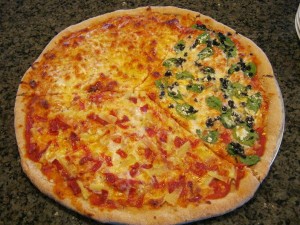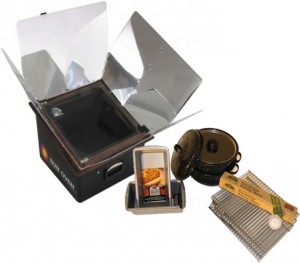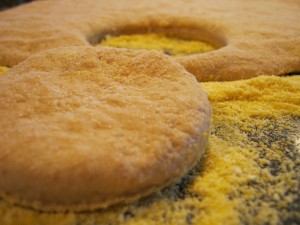 One of the biggest joys of freshly milled whole wheat at home is experimenting and finding out just what can be made. Having the whole grain on hand, milling it and using it in a variety of ways just opens the doors wide for budget stretching and nutrition!
One of the biggest joys of freshly milled whole wheat at home is experimenting and finding out just what can be made. Having the whole grain on hand, milling it and using it in a variety of ways just opens the doors wide for budget stretching and nutrition!
I used to think that English Muffins were one of the most difficult things to make. I mean, look at them! They are small discs of toasty goodness with the pull apart texture that makes them toast better than any slice of bread. Not to mention, we have always made Egg-Mc-Miller-Muffins for special occasions and I was afraid I’d mess things up by trying to make a Whole Wheat English Muffin. Boy, was I glad to be WRONG!
The May 31st Newsletter will have the full recipe and steps for making your own whole wheat English Muffins. Trust me, if I could do it – you can do it! So be sure you’re signed up for the Newsletter. Also, we’ll be 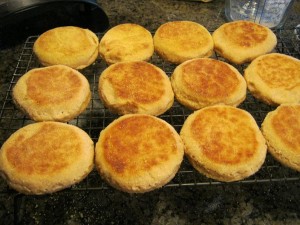 having a live video class on this – so you can see the techniques and ask questions! We’ll notify you of that class in the newsletter too!
having a live video class on this – so you can see the techniques and ask questions! We’ll notify you of that class in the newsletter too!
I’ll leave you with my favorite picture from my adventures in Whole Wheat English Muffins!
EnJOY playing with your food! You may never know what you can do until you try!
Home-made Whole Wheat (freshly milled!) Pizza Crust can be made easily ahead of time to make even the most hectic evening meals both fast and healthy. With variety and choices of toppings it can be a great family pleaser! I mean, who doesn’t like to choose their own toppings on pizza, right?
From fresh herbs to your own simply made tomato sauce (ground tomatoes) there are endless possibilities to toss on top of this crust and have dinner in a flash. The secret is making several of these healthy crusts ahead of time and freezing them!
Here’s the simple way to do it.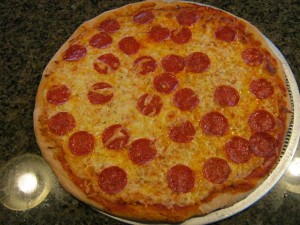
First use freshly milled whole wheat in your favorite recipe. You can see mine on our VIDEO ARCHIVES.
Second, buy the large turkey roasting bags at the grocer.
Third, when making these only par-bake them at 350 for between 8-10 minutes until lightly cooked.
Then cool completely, bag and put in the freezer. Stack them inside the turkey roasting bag, twist tie and freeze! Ready to be used when you’re short on time, but don’t want to short change your family on healthy food!
Then when you have only 15 minutes to have dinner on the table – pull one out, decorate as you like and bake for about 10 minutes at 400 degrees. Within less time than it takes to drive to the take-out pizza place you’ve got a far healthier and budget friendly dinner ready to go!
By using freshly milled whole wheat – you also enjoy the flavor of the pizza without the over powering taste of the bagged whole wheat flour ruining the sauce, cheese and toppings! So if you’ve not thought of a mill you’d like yet…please view our GRAIN MILL COMPARISON CHART to get started!
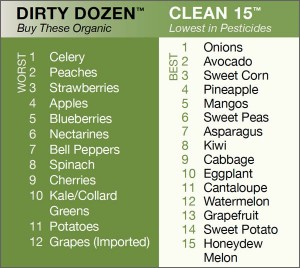 If there were one budget benefit to the rising food prices of our current economic climate, it would be that the prices of ‘regular’ produce have virtually met the price of organic produce. Now making the choice between the two options does not have the same wide cost comparison. Yet again, knowing just what to purchase as organic and what is lower in pesticides is always a good thing to keep in mind when trying to provide healthy foods on a budget.
If there were one budget benefit to the rising food prices of our current economic climate, it would be that the prices of ‘regular’ produce have virtually met the price of organic produce. Now making the choice between the two options does not have the same wide cost comparison. Yet again, knowing just what to purchase as organic and what is lower in pesticides is always a good thing to keep in mind when trying to provide healthy foods on a budget.
There are lists like the one pictured here in this article that can be helpful in deciphering just what to spend your money on when planning your grocery budget. Organic Produce and Low Pesticide Produce are categorized into the ‘Dirty Dozen’ or the ‘Clean Fifteen’. The trick here is to remember them. I can barely remember to take the list of needed items and coupons, so this additional list will likely get left on the kitchen counter instead of in my hand at the grocery store. However, there are a few tips and tricks to help you remember what are the best choices:
- Print out and potentially laminate the list above and keep it in your wallet or check book. This way it is always with you, even when you happen upon a farmers market or fruit stand. I also do this with printer cartridge information for the copier.
- Forgot your list? No worries, just remember that most of the fruits and vegetable s that you also eat the skin or peel (or that the peal is fuzzy and absorbent) you will want to purchase as organic. Produce that you peel or remove the outer layer are often lower in pesticides both during the growing process and you habitually lower the intake by removing the outer layer before consuming.
- Most produce has 4 to 5 numbers on the sticker. Look at the first one to know what you are getting: Starts with a “9” – Organically Grown and non GMO. Starts with “3 or 4” – Conventionally grown, not genetically modified (non-GMO), but also not organic. Starts with an “8” – Genetically modified (DNA altered), so hate eight.
- Last but certainly not least, and definitely the most trustworthy and budget friendly approach….grow your own! Not only will it save money, you’ll have the satisfaction of knowing what went into the process, appreciate the end product and enjoy the taste far more!
Hopefully this will help as you approach your produce selection to feel you are confidently spending your hard earned budget money on food that best nourishes your family. Listen to the April 18, 2012 episode of “Encouragement in the Kitchen” for more insight and encouragement about this topic.
Next week on April 10th, 2012 Millers Grain House is delighted to be offering a Solar Cooking Class at the local fairgrounds. Given the price of electricity and the need to practice greener, self-sustaining skills, the Global Sun Oven is becoming one of our new favorite cooking options.
The Dehydrating Prep Pack makes this a very versatile oven that does far more than slow cook! It’s not your chintzy solar cooker.
The Global Sun Oven bakes, broils, steams, dry boils eggs, purifies water, dehydrates and can be used to sprout! This is the only solar cooking device that we have found to reach baking temperatures of up to 400 degrees. Most people know that to bake muffins or bread, it must reach and sustain this temperature. It does!
At the upcoming class we will demonstrate baking muffins and meat and dehydrating a 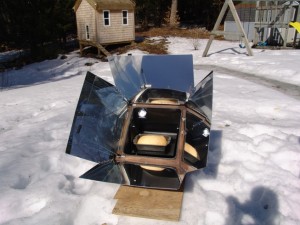 variety of foods. Each participant with get to play with the Global Sun Oven and see just how easy it is to use. This is my favorite new toy, I mean, tool! So much so, that it feels like I’m playing with an easy bake oven!
variety of foods. Each participant with get to play with the Global Sun Oven and see just how easy it is to use. This is my favorite new toy, I mean, tool! So much so, that it feels like I’m playing with an easy bake oven!
The versatility and durability of the Global Sun Oven has made it to be my only recommended Solar Oven to date. There really is no match to it.
Stop by here and see how my very first loaf of freshly milled whole wheat bread in the Global Sun Oven did! It’s the video in the lowest left hand corner. EnJOY!
Have you ever faced the end of a holiday season and had an overflow of foods that are usually not eaten through out the year? We face this after almost each holiday and ti forces me to become creative to avoid wasting food.
Usually, I clean out the refrigerator a little each week, but after a holiday – this required some serious attention. Weekly refrigerator cleaning is key to stretching the grocery dollars.
Although usually my focus is on whole wheat , the truth is that although whole grains are a great base for a healthy and frugal grocery budget, they are not alone on the menu. Learning to make the most of each ingredient, fresh, frozen, or otherwise will help make the most of your groceries and help them to stretch giving you more life for your dollar.
We hope you enjoy the video and subscribe. There are more ideas to prolong the life of your food in the remainder of the series.
 Last week I began my show on choosing, using and storing healthy oils only to discover 3 minutes before the show was to end that my microphone was muted. Needless to say, this is now the topic of the upcoming radio show!
Last week I began my show on choosing, using and storing healthy oils only to discover 3 minutes before the show was to end that my microphone was muted. Needless to say, this is now the topic of the upcoming radio show!
Choosing, storing and using healthy oils is the key to making good choices in your diet. Your health is not only affected by the type of oil you choose, but also how you use it. Over heating can actually turn a good fat into a bad fat (trans fat). Storing oil is also vital to making sure you don’t get sick by using oil that has gone rancid.
Fat and oil have gotten a bad wrap over the years. The truth is that not all fats are created equal. Your brain, your hair, your skin and your arteries need healthy oils and healthy fat to function properly. The key is learning what choices to make and what to stay away from.
I will share with you a bit more information about healthy oils! Some of the topics that will be touched on are:
- What are the smoke points of oils and why is that important information?
- Should you worry about the fat content and type?
- Decipher single chain, Mono-Unsaturated Fatty Acids.
- Is there such a thing as a healthy saturated fat?
- How to spot ‘impostor olive oil’ in the grocery isle.
- What about the spray oils or non-stick sprays?
Stop by our Facebook Page if you have specific questions about this topic and leave a comment/question.
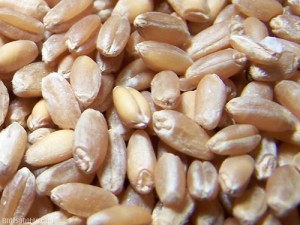 In videos, recipes and general conversation around my home, when we say the words, “whole wheat”, we only mean freshly milled whole wheat.
In videos, recipes and general conversation around my home, when we say the words, “whole wheat”, we only mean freshly milled whole wheat.
When we say flour, we mean freshly milled whole wheat flour.
We just don’t use any other type.
Dead-Whole-Wheat-Bagged-Flour has oxidized as it has sat in the bag. Also the miniscule amount of vitamin E (wheat germ oil) left after the majority of it being stripped from the grain during processing (for shelf life) has begun to go rancid. That is the bitter taste.
We have not used bagged whole wheat flour or bagged enriched white flour for YEARS. However, when sharing recipes, we may often simplify by just saying whole wheat or flour, but we always mean flour that has been freshly milled at home from the whole grain of wheat.
Coming soon is a brief video explanation of WHY we use freshly milled whole wheat flour on our YouTube Channel. Go subscribe to that channel to be more informed!
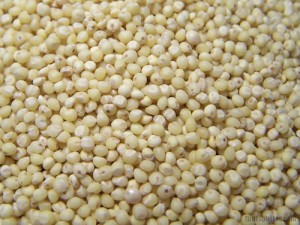 Low gluten and gluten-free items can be very expensive to buy in the store. So if you want to know what you’re getting and if it ‘s right for your gluten-free or lower gluten diet, it would be good to learn a little more about the grains you can use. I began my journey in home-milling because of a diagnosis of gluten sensitivity. Thankfully I found it was the processing of wheat flour that was my issue, not the gluten (as is the case in many people’s mis-diagnosis) and I can again eat freshly milled whole wheat. But I did learn of several grains that work well for a lower gluten or gluten-free diet.
Low gluten and gluten-free items can be very expensive to buy in the store. So if you want to know what you’re getting and if it ‘s right for your gluten-free or lower gluten diet, it would be good to learn a little more about the grains you can use. I began my journey in home-milling because of a diagnosis of gluten sensitivity. Thankfully I found it was the processing of wheat flour that was my issue, not the gluten (as is the case in many people’s mis-diagnosis) and I can again eat freshly milled whole wheat. But I did learn of several grains that work well for a lower gluten or gluten-free diet.
Because these grains all contain a trace to no gluten, they will all require some kind of binding agent in the recipe in which you use them. Gluten protein forms strands to hold dough together when baking. These grains do not have those strands so you cannot replace the milled flour of a low to no gluten grain exactly for wheat flour.
Millet (pictured above) is one of the staples in a gluten free diet. Millet can be cooked as a replacement for couscous (which is a wheat pasta, not a grain) or milled into a flour.
Quinoa is another low gluten grain. It is very high in protein and also cooks well whole.
Rice is a gluten-free grain. When milled the flour is very fine and suitable for thickening sauces.
Rye is an extremely low gluten grain. The flour is suitable for baking flat breads and using in batter bread mixtures.
Corn is low gluten. There is a trace amount of gluten & starch in some corn meals.
Oats can contain a trace amount of gluten. If you suffer from Candida or Celiac’s , be sure the oats you purchase are labeled ‘Gluten-Free’ since not all oats are gluten free.
Spelt is another grain often used in low to no gluten diets, but it does indeed have trace amounts of gluten in it. It can be kneaded but only for a short time after which over kneading causes the dough to become very sticky.
Kamut is not low or gluten-free. Kamut is an ancient grain akin to today’s wheat derivative.
Let me encourage you that if you have been diagnosed with a gluten sensitivity or a gluten intolerance, you may be able to enjoy whole wheat bread again if you mill the wheat at home and use it fresh. However, if you have been diagnosed with Candida or Celiac’s consider milling these low to no gluten grains at home to save yourself some money and give you variety in your diet.
 I am regularly asked: “Why should I mill whole wheat and grains at home“? It’s certainly an important question, and one that I asked myself when I first became interested in whole wheat and grains. Now, I know why it is so important!
I am regularly asked: “Why should I mill whole wheat and grains at home“? It’s certainly an important question, and one that I asked myself when I first became interested in whole wheat and grains. Now, I know why it is so important!
On my weekly radio show, I explore the topic and offer some insights. We want to share that recording with you and hope you will offer your comments below.
We certainly want to invite you to attend our weekly live show, “Encouragement in the Kitchen.” If you are unable to attend, we record the shows and post the audio recordings in our radio archives section.
We always love to hear your comments.
Best Blessings!
I hope you’ve had the chance to view our daughters’ video: Pancakes from Scratch. Below the video is the (whole) recipe and a little history behind this recipe that is a Miller Family Weekend Staple.
Usually every Sunday, we have either Whole Wheat pancakes made from scratch or Whole Grain Waffles made from scratch. As the girls show you above, it is actually quick and simple to mix all the dry ingredients together in one container and all the wet ingredients together in another the night before and have easy, almost instant Whole Wheat Pancakes faster than a box mix.
Heart-healthy Whole Wheat Pancakes
Wet Ingredients:
2 1/2 Cups of Low Fat Buttermilk
1/2 Cups Egg Whites
2 Whole Eggs
1/4 Cups Canola Oil
1 tsp Vanilla Extract
Dry Ingredients:
4 Cups Fresh-Milled Whole Wheat (white wheat) Flour
2 tbsp Sugar
1 tsp Baking Soda
1 tsp Salt
2 1/2 tsp Baking Powder
Just follow their lead for instructions!
If you have left over pancakes (we do that on purpose) allow them to cool on a cooling rack and place in a zip-lock bag with wax or parchment paper between them and freeze. They pull out singularly and toast in a toaster to the perfect pancake once again! Great for those mornings on the go!
By the way, the ‘Yellow Bowl’ featured in many of our videos is the famous yellow bowl that has been in my newsletters before. It is one of the inanimate objects I would try to grab in a house fire. The reason is because it was one of the first things given to me by my mother-in-law (who also influenced my and the daughters’ love of cooking) and because we have so many family meals together that the beginnings of which start in that yellow bowl. It, it priceless only because it links me to my greatest gift on earth, my family.
I hope you enJOY and become a part of the Millers Grain House extended family by subscribing to our Newsletter. You’ll get free recipes!!

